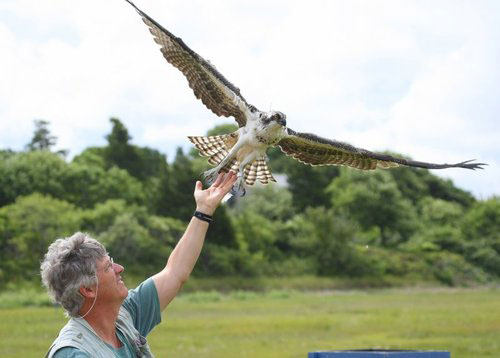
Rob Bierregaard
The Henry L. Ferguson Museum is pleased to announce that the Spofford Foundation has generously pledged funds to facilitate the ”tagging” of one adult male osprey on Fishers Island with a transmitter that will enable interested parties to track the selected bird’s travel patterns via daily Google Earth downloads.
The approximately one-ounce transmitter, carried like a tiny “backpack” by the osprey, will provide data that reveal both where our bird is foraging around Fishers Island, and its long-range migratory route to and from its wintering ground. Ospreys from the northeast often winter in South America, so it will be exciting to discover if our bird’s destination is Brazil, or Venezuela, or Suriname, or French Guiana, or… N.J.?
The osprey “tagging” project was initiated more than a decade ago by Mark Martell at Minnesota Audubon and Rob Bierregaard of the University of North Carolina, Charlotte. Since 2000, more than 150 “tagged” ospreys have been tracked, providing data that are useful for ornithologists and researchers who specialize in protecting and studying this raptor. Mr. Bierregaard, who has been studying osprey populations since 1969, will make a trip to Fishers Island in late April or early May to briefly trap the osprey in order to strap the small transmitter on its back. (The trapping is done with a fish line net that entangles the osprey’s feet.) Our first choice will be the adult male at the Middle Farms nest that is covered by the HLFM’s Osprey Cam, but a backup nest will be chosen if necessary.
The notion of “tagging” a Fishers Island osprey has been under discussion for several years. Osprey-expert Alan Poole broached the subject at a Museum lecture in 2009. Nick Spofford, a member of the Fishers Island Conservancy, was an early proponent of the project, as was John Ski, who helped initiate contact with Mr. Bierregaard. The Fishers Island Utility Co. has provided strong and essential support for both the Osprey Cam and this new project. The Henry L. Ferguson Museum is especially grateful to John Spofford for pledging the grant from the Spofford Foundation that makes this exciting project possible.
Many thanks to all involved!

